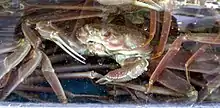Chionoecetes
Chionoecetes is a genus of crabs that live in the northern Pacific and Atlantic Oceans.[1]
| Chionoecetes | |
|---|---|
 | |
| Chionoecetes bairdi | |
 | |
| Chionoecetes opilio | |
| Scientific classification | |
| Kingdom: | Animalia |
| Phylum: | Arthropoda |
| Subphylum: | Crustacea |
| Class: | Malacostraca |
| Order: | Decapoda |
| Infraorder: | Brachyura |
| Family: | Oregoniidae |
| Genus: | Chionoecetes Krøyer, 1838 |
| Species | |
|
See text | |
Other names for crabs in this genus include "queen crab" (in Canada) and "spider crab" – they are known by different names in different areas of the world. The generic name Chionoecetes means snow (χιών, chion) inhabitant (οἰκητης, oiketes);[2] opilio means shepherd, and C. opilio is the primary species referred to as snow crab. Marketing strategies, however, employ snow crab for any species in the genus Chionoecetes. The name "snow crab" refers to their being commonly found in cold northern oceans.
General
Snow crab are caught as far north as the Arctic Ocean, from Newfoundland to Greenland and north of Norway in the Atlantic Ocean, and across the Pacific Ocean, including the Sea of Japan, the Bering Sea, the Gulf of Alaska, Norton Sound, and even as far south as California for Chionoecetes bairdi.
In 2019 the Norwegian Supreme Court ruled that the species is considered a sedentary species living on the seabed, and thus governed by the United Nations Law of the Sea.[3]
Species

Seven extant species are currently recognised in the genus:[4]
- Chionoecetes angulatus Rathbun, 1893 – triangle tanner crab
- Chionoecetes bairdi Rathbun, 1893 – tanner crab, bairdi, or inshore tanner crab
- Chionoecetes elongatus Rathbun, 1925
- Chionoecetes japonicus Rathbun, 1932 – beni-zuwai crab
- Chionoecetes opilio (Fabricius, 1788) – snow crab or opilio
- Chionoecetes pacificus Sakai, 1978
- Chionoecetes tanneri Rathbun, 1893 – grooved tanner crab
Cookery
Crabs are prepared and eaten as a dish in many different ways all over the world. The legs are usually served in clusters and are steamed, boiled, or grilled. Snow crab can also be used as an ingredient in other dishes such as snow crab macaroni and cheese.[5]
References
- L. S. Jadamec; W. E. Donaldson & P. Cullenberg (1999). Biological Field Techniques for Chionoecetes crabs. University of Alaska Sea Grant College Program. Chapter 1 - Taxonomic I ppppppoArchived 2005-11-13 at the Wayback Machine [http://www.uaf.edu/seagrant/bookstore/pubs/AK-SG-99-02-b.pdf Chapter 2 - Life History [other chapters can be opened from the Document Outline view in Firefox only. PDF file names end in letters a-d, all on Web Archive]
- Henrik Kröyer (1838). "Conspectus Crustaceorum Groenlandiae" [Survey of the crustaceans of Greenland]. Naturhistorisk Tidsskrift (in Latin). 2: 249–261.
- "Abide by the claw: Norway's Arctic snow crab ruling boosts claim to oil". Reuters. February 14, 2019.
- Peter K. L. Ng; Danièle Guinot & Peter J. F. Davie (2008). "Systema Brachyurorum: Part I. An annotated checklist of extant Brachyuran crabs of the world". Raffles Bulletin of Zoology. 17: 1–286. CiteSeerX 10.1.1.649.2033. [with Corrigenda and Errata on pg 287-313]
- "Freash Maryland Seafood Delivered Right To Your Door". Archived from the original on 2019-07-09. Retrieved 2019-01-04.
